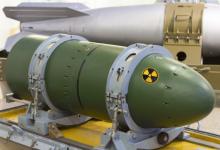Explosive weapons
Marine traffic through Bosporus unaffected by mines: Defense minister
The Turkish army is continuing to stay vigilant against the naval mines in the Black Sea, the defense minister has said, stressing that marine traffic through the Bosporus is not affected by the drifting sea mines and runs as usual.
Turkish fishermen in Black Sea closely watch navy boats
Turkish fisherman Şahin Afsüt fears the worst: Hitting a mine and "disappearing underwater in the blink of an eye."
Like many fishermen in Rumelifeneri, a village set on the rocks of the Bosphorus in northern Istanbul, Afsüt and his team remain in port since the discovery of a drifting mine last month in the Black Sea.
It is becoming more certain: Some state will use nuclear weapons
The institute claims that this could break the tendency to reduce the nuclear arsenal.
According to experts, this tendency increases the probability that a country will use nuclear weapons in war.
Magawa the hero rat retires from job detecting landmines
In a five-year career, the rodent sniffed out 71 landmines and dozens more unexploded items in Cambodia
Post-War Kosovo Becomes Hub for Mine-Clearance Expertise
Yugoslav-era mines lie scattered across the ground in an area marked off with sticks. In the middle of the area, the remains of a dead animal can be seen.
To the left, another zone is marked as 'contaminated' with unexploded ordnance, although no mines are visible to the eye. Instead they are covered by vegetation, even deadlier than if they were in plain sight.
London Neighbourhood Evacuated over a Bomb
The unexploded bomb is found in an area with many shops, restaurants, bars and offices
British police have isolated one of the busiest parts of central London after an unexploded WWII bomb was discovered at a construction site.
- Read more about London Neighbourhood Evacuated over a Bomb
- Log in to post comments
Police destroy explosive device outside precinct in Zografou
Members of the Greek Police's (ELAS) bomb disposal unit on Monday used a controlled explosion to destroy a homemade explosive device that was found outside a police precinct in Zografou, eastern Athens.
The device had been placed inside a metal pipe which was inside a box placed on a wall opposite the precinct. It contained nails and had a timer, according to police sources.
Turkey destroys 40 mines, 227 explosives in northern Syria
Turkish security forces have destroyed 40 mines and 227 improvised explosives in its anti-terror operation in northern Syria, the country's National Defense Ministry said on Oct. 24.
15,000 People Were Evacuated in Hanover Because of a World War II Aerial Bomb
Nearly 15,000 people were evacuated Monday night in the German city of Hanover due to a World War II aerial bomb disposal operation, BTA reported.
The 500-pound projectile was discovered on a construction site.
According to estimates, at the end of World War II, over 2 million bombs of different caliber were thrown over Hitler's Germany. 10-20% of them never exploded.
Wartime Landmines Still Taking Lives in Bosnia
When two deminers were killed on August 25 nearby the town of Livno in south-west Bosnia while they were on duty in one of the minefields that still blight the country, it again highlighted the dangers faced by those who are working to clear the remaining unexploded ordnance left over from the 1992-95 war.
- Read more about Wartime Landmines Still Taking Lives in Bosnia
- Log in to post comments









